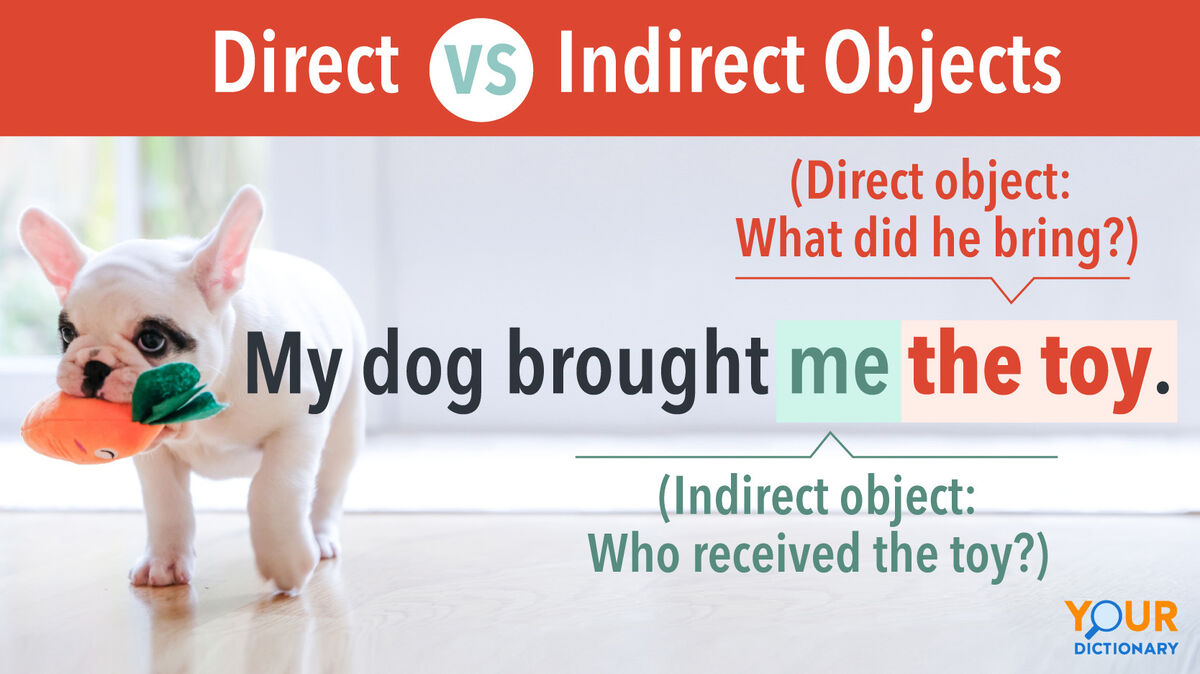
Every sentence needs a subject and a verb to be complete. But sentences with direct objects provide more information — and sentences with indirect objects can be even more explanatory. Learn how to clarify your meaning with a guide to the differences between direct and indirect objects.
The Main Difference Between Direct and Indirect Objects
When you read a longer sentence, finding the direct and indirect objects may seem tricky. But it's easy once you know the questions each part of a sentence answers.
Object | Answers the Questions | Example |
| direct object | Who? What? | Patty gave me a gift. |
| indirect object | To whom or what? For whom or what? | Patty gave me a gift. |
If a sentence only has one object (such as "Patty gave a gift"), that's the direct object. A sentence with only an indirect object (such as "Patty gave me") doesn't make sense.
Direct Objects Receive the Action
You can easily find a direct object by finding the verb in a sentence. Direct objects receive the action in the sentence and answer the question "Who?" or "What?" If the direct object is a pronoun, it must be an object pronoun.
For example:
- The teacher taught a math lesson. (What did she teach?)
- My best friend wrote an email. (What did he write?)
- Miguel passed the ball. (What did he pass?)
The verbs in these sentences are known as transitive verbs. They "transfer" action from the subject to the direct object. Intransitive verbs such as laugh, swim or run don't need direct objects to complete their action. You also don't use direct objects with linking verbs such as is or become.
Indirect Objects Receive the Direct Objects
Once you have a sentence with a direct object, you may find that you need an indirect object. Indirect objects receive the direct objects and answer the questions "To whom (or what)?" and "For whom (or what)?" They often come after prepositions such as to or for. For example:
- The teacher taught a math lesson to the class. (Who received the lesson?)
- My best friend wrote an email to his parents. (Who received the email?)
- Miguel passed the ball to his teammate. (Who received the ball?)
Switching the order of the objects doesn't change the meaning of the sentence, and it doesn't change the function of each object. For example:
- The teacher taught the class a math lesson. (Who received the lesson?)
- My best friend wrote his parents an email. (Who received the email?)
- Miguel passed his teammate the ball. (Who received the ball?)
Some grammarians believe that if the indirect object follows a preposition, it's automatically the object of a preposition. However, if you can move the noun just after the verb and the sentence still makes sense (as in the examples above), it's an indirect object.
Examples of Direct and Indirect Objects in a Sentence
Check out the direct and indirect objects in the following sentences. Direct objects are bolded while indirect objects are underlined.
- Peter told a lie to his parents.
- We're planning a surprise party for Kendra.
- I found you a new apartment!
- My dog brought me the toy.
- The server read us the daily specials.
- Mr. Howard fixed the mailbox for me.
- Can you make my dad a salad?
- Let's buy these sleds for our next snow day.
Make Grammar Skills Your Objective
Learning the parts of a sentence can help you become a better writer. Once you know the difference between direct and indirect objects, you can vary your sentence structure and effectively check for errors in your writing. If you're planning a grammar lesson on direct and indirect objects, try out a few engaging activities on identifying objects in sentences.